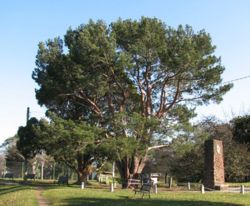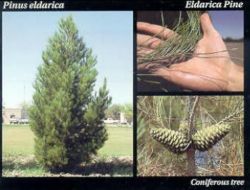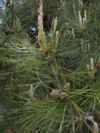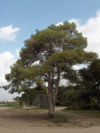Turkish pine
| Turkish pine |
|---|

|
| Scientific Classification |
| Binomial Name |
|
Pinus brutia |
Turkish Pines are closely related to the Aleppo Pine, Canary Island Pine and Maritime Pine, and adapts well in direct sunlight with dry, hot air. They are used to decorate and shield out the sun in parks, and places were there could be a lot of people. [1]
The Turkish Pine attracts sap-sucking aphids. The excess sugar is collected by the honey bee, and then produces honey dew.(aka. pine honey)[2]
Anatomy
They are considered to be medium size trees and range from twenty to thirty-five meters tall. The trunk is a red brown color. The needles come in pairs of two, about ten to six-teen cm.long. They have short cones that are a brownish red color that grow in bunches. [3]
Reproduction
For their reproduction they have cones about 6-7 cm. long and about 4-5 cm. wide. They take about one to two years for them to mature and open to release the seeds inside. The seeds are 7-8 mm long and are usually spread by the wind. [4]
Ecology
Turkish Pines are mainly located in Turkey but are also common in the East Aegean Islands. They are planted around for decoration in parks, and gardens. They can tolerate high heat and flourish well in droughts, People use them widely for limber. Turkish Pines have other names that they are known for like, Calabrian Pine, East Mediterranean Pine, and Brutia Pine.[[5]]
 Browse |
Related References
- Turkish Pine Answers.com
- Turkish Pine Wikipedia



